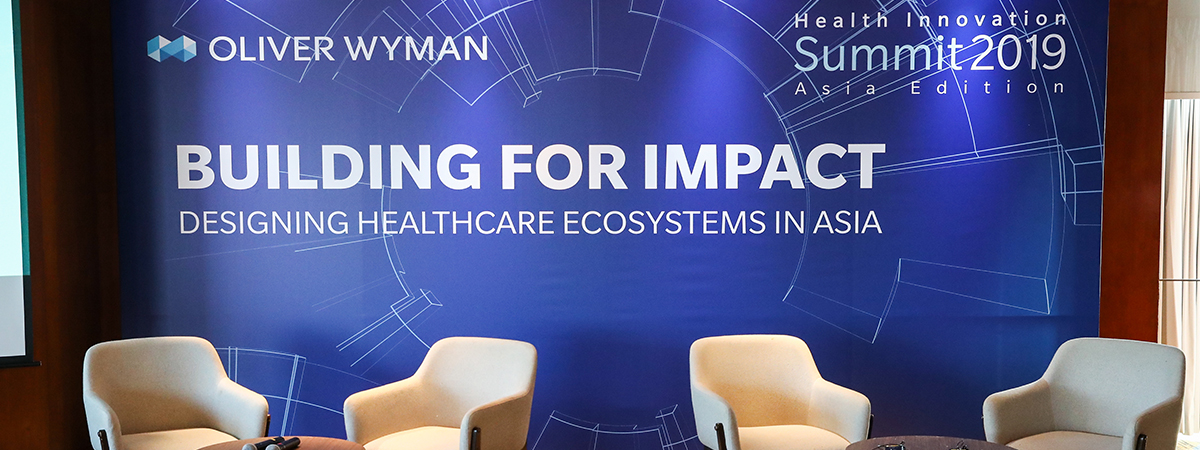Editor’s Note: For more executive conversations on Asian healthcare, read our Q&As with two of this year's Singapore Summit speakers, Amazon Web Services (AWS) and AXA.
What’s the future of Asia’s healthcare system? We discussed this question at the second annual Oliver Wyman Health Innovation Summit – Asia Edition 2019 – with over 70 executives from 30 companies including AWS, DBS, and the National Health System. The event highlight was a panel presenting perspectives on topics like how to scale technical innovations from the US across Asia, with panelists including: Shee Tse Koon (DBS’ Group Executive and Singapore Country Head), Vincent Quah (Regional Head – Education, Research, Healthcare & Not for Profit, APAC Public Sector, Amazon Web Services) and Soo Min Wong (National University Health System’s Group Chief Financial Officer). The panel was moderated by Oliver Wyman Health & Life Sciences Partner, Jeremy Lim, MD, MPH. Oliver Wyman Partner, Sam Glick, and Oliver Wyman Principal, Rachel Zeldin, also shared how global industry perspectives apply specifically to Asia. (For more on Rachel’s perspective, which she shared in a keynote, see The Right Way to Build for Impact.)
Here are three big ideas regarding what our presenters had to say.

1. Frictionless Healthcare is Possible
Healthcare across Asia cannot afford to remain unchanged. “Patients are impatient,” said Soo Min. In an ideal healthcare ecosystem, patients must be equal stakeholders. This means incumbents, whether providers, payors, or other suppliers, must place higher focus on efficiency and quality of the patient experience at every interaction.
Asia has been quick to experiment in innovative customer journeys in other industries. “Why can’t we model the healthcare customer experience after an online shopping experience?” asked Vincent.
When it comes to financial services, retail banking institutions are continuously striving for the frictionless customer experience, but at the same time must never fail to maintain robust customer identification. As cyber threats have become more complex, so too have these identification verification tools. Healthcare, likewise, has its own issues with fraud and abuse of the system where every new solution adds a new process to the patient journey, at worse delaying care. Speakers emphasized a new future where invisible administration is your healthcare interaction – no forms, no claims, one-click checkout.
2. It's All About Non-Traditional Players
As another non-traditional healthcare player, banks are no longer restricting themselves to act as just payment channels, but are playing active roles as partners in healthcare. For instance, Siam Commercial Bank has built a digital hospital, providing patients with access to virtual healthcare services.
Technology players are also creating verticals in healthcare, especially as they package solutions into modules to speed up the innovation cycle. For example, AWS can help health systems that are “data-rich but insight-poor” quickly achieve analytics capabilities by subscribing to cloud-based services purpose-built for healthcare needs, without making costly infrastructure investments.
While the incumbents focus on their brick and mortar domains, technology has leveled the playing field and opened the door for new participants. To survive, “the way forward is discarding the single role and embracing the multiplayer, multi-role partnership,” said Rachel. “Players will have to be ‘asset agile’, equip the workforce with technological skills, and scale innovations to communities.”
3. Asian Consumers Really Want Digital Health Innovation
Healthcare is getting personal. Speakers mentioned artificial intelligence, for instance, has been shown to detect Post-Traumatic Stress Disorder 20 percent more often than trained psychologists. Or, Catalia Health’s little wide-eyed robot named Mabu that's nudging those with chronic conditions to live better.
Asian consumers want more personalized care and are willing to use technology to get there, emphasized our visiting speakers, who reflected on key learnings from the US market to apply to Asia. For instance, according to a global survey from Mercer and Oliver Wyman, nearly half of the Singaporean consumers are willing to accept digital innovation. “Asian consumers are more willing and far more demanding than their Western counterparts,” explained Sam.
Our speakers also added that, while rising cost has been the main driver for innovation in the US, medical expenses in much of Asia are much more reasonable. This means innovative examples in Asia can also support other use cases, beyond lowering cost, such as managing public hospital waiting times or eliminating travel distances by delivering more care remotely. Notably, multiple markets mean diverse demographics, and thus opportunities to execute on new propositions that address someone’s needs.
With Asia primed to lead the future of healthcare innovation, stay tuned for next year’s Oliver Wyman Health Innovation Summit 2020 – Asia Edition.
